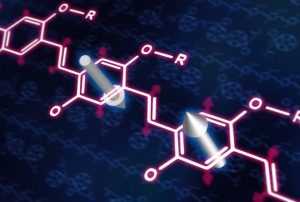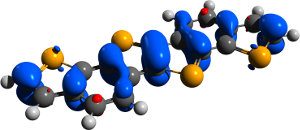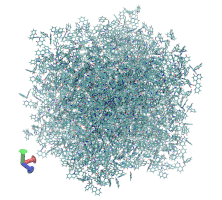
In many areas of solid state technology (e. g. photonics and photovoltaics), efforts are underway to replace traditional semi-conductor materials with components based on organic molecules. While generally aiming for cheaper industrial production, more abundant raw materials and significantly greater tailorability and versatility of materials, molecular materials science has already produced a number of unique and superior technologies, such as OLED-based displays in smartphones. Organic spintronics seeks to bring these advantages to the field of spintronics. Our team makes up the theory node in an interdisciplinary collaboration funded by a Synergy Grant awarded by the European Research Commission (ERC).
From Single Molecules to Realistic Material Models
 Collaborating closely with experimentalists, we seek high-quality predictions and maximal complementarity in our theoretical modeling. We try to understand spin dynamics in realistic material models, from the interactions of single electrons all the way up to meso-scale ensemble effects in molecular materials, without resorting to empiricism or oversimplification. We achieve this using a wide range of techniques from first-principles theory, chiefly density functional theory (DFT), DFT perturbation and -response theory, and tight-binding Hamiltonians. We go from studying small systems in great detail to semi-classical models of large systems, mainly using kinetic Monte Carlo (KMC), while tying all the various size-, time- and energy-scales together in so-called multi-scale modeling.
Collaborating closely with experimentalists, we seek high-quality predictions and maximal complementarity in our theoretical modeling. We try to understand spin dynamics in realistic material models, from the interactions of single electrons all the way up to meso-scale ensemble effects in molecular materials, without resorting to empiricism or oversimplification. We achieve this using a wide range of techniques from first-principles theory, chiefly density functional theory (DFT), DFT perturbation and -response theory, and tight-binding Hamiltonians. We go from studying small systems in great detail to semi-classical models of large systems, mainly using kinetic Monte Carlo (KMC), while tying all the various size-, time- and energy-scales together in so-called multi-scale modeling.
We employ a number of electronic structure theory software packages such as NWChem, ORCA, DIRAC, SIESTA, and Quantum ESPRESSO. For state-of-the-art electron dynamics in soft matter, we use the multi-scale modeling VOTCA toolkit, with which we are developing a unique extension for spin dynamics in organic materials, VOTCA-STP.
Team

The ERC Synergy Grant and Other Collaborations
We have the great fortune of closely collaborating with several of the leading groups in our field(s).
Within the Synergy Grant, we collaborate with the groups of
- Prof. Sirringhaus, Cambridge Cavendish Laboratory, UK
- Prof. McCulloch, Imperial College, UK
- Prof. Wunderlich, Cambridge Hitachi Laboratory, UK
- Prof. Nelson, Imperial College, UK
Outside the Synergy Grant, we collaborate with
- Prof. Egorov, University of Virginia, USA
- the group of Dr. Andrienko, Max Planck Institute for Polymer Research, Germany
- the group of Dr. Beljonne, University of Mons, Belgium
Peer-Reviewed Team Publications as of 2020.08.04
- "Quantifying the inverse spin-Hall effect in highly doped PEDOT:PSS". Phys. Rev. Res. 2, 013207 (2020)
- "Tuning Spin Current Injection at Ferromagnet-Nonmagnet Interfaces by Molecular Design". Phys. Rev. Lett. 124, 027204 (2020)
- "Accurate and general formalism for spin-mixing parameter calculations". Phys. Rev. B 100, 134410 (2019)
- "Chemical and Structural Trends in the Spin-Admixture Parameter of Organic Semiconductor Molecules". J. Phys. Chem. C 123, 19112 (2019)
- "Polaron spin dynamics in high-mobility polymeric semiconductors". Nat. Phys. 15, 814 (2019)
- "Long spin diffusion lengths in doped conjugated polymers due to enhanced exchange coupling". Nat. Electron. 2, 98 (2019)
- "Molecular tuning of the magnetic response in organic semiconductors" . Phys. Rev. Mater. 2, 074405 (2018)
- "Tuning the effective spin-orbit coupling in molecular semiconductors" . Nat. Comm. 8, 15200 (2017)
